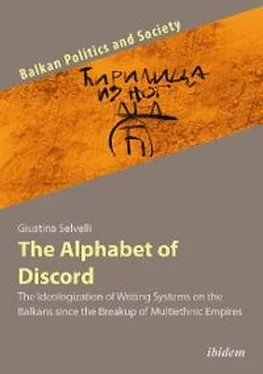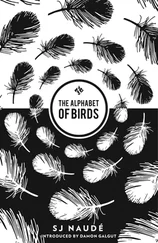In this book there are only very brief references to the properly subjective aspect of the question, while much more space is devoted to examining the role of popular culture in propagating certain identity messages associated with the alphabet, that is, the question of the transformation of discourse from official to popular. This component of the analysis is considered fundamental in demonstrating how the so-called “operative level” (Malešević 2002: 74-75) of ideology is propagated through a much more effective and direct discourse and language than the primary, official one. Therefore, the level of ordinary and (seemingly) spontaneous practice, a context that might seem detached from the first two, actually represents the most obvious and evident reflection of the penetration of official discourse into the daily life of large segments of the population (Malešević 2013: 120-154).
The main inspiration for the development of this research was provided by the illuminating insights offered by the field of the anthropology of writing as practiced by its most eminent representative, Giorgio Raimondo Cardona (1943-1988). 2This branch of anthropology is the one that has so far paid more attention than any other to the symbolic, cultural and ideological aspect of writing systems (especially in: Cardona 1982, 1986, 2009 [1981], 2009a). It assumes that writing systems represent much more than a simple representation of sounds, bearing a fundamental symbolic dimension that is often underestimated, and which enables them to “emancipate themselves” from their linguistic context. 3
Writing is understood as both a cultural and a social practice: written texts are central to culture conceived in the broad sense, which in turn is closely linked to society (Cardona 2009a: 64ff). The alphabet also proves to be a privileged site of symbolic production, becoming an effective means of reminding people who they are at the national collective level: in the Bulgarian and Croatian cases, as we shall see, this is fully expressed and linked to modern ideologies of state legitimacy. In the dissemination of identitarian rhetoric, the symbolic aspect of the alphabet plays an important role, stimulating national consciousness and internal cohesion through the use of elements such as writing, which is conceived as an “identity and symbolic marker” (cf. Malešević 2004: 26). Intellectuals, legitimized by the political sphere (cf. Smith 2009: 84-86), can indeed make certain textualities and messages decisive in propagating certain forms of ideologies: in the cases analyzed in this book, they correspond to “script ideologies.”
To understand how writing and written texts are produced and used by different actors in different contexts, we need to examine the values, beliefs and behaviors associated with different forms of writing (Barton & Papen 2010: 9). 4For this reason, an important focus is placed on those who hold power over writing culture and on the ways in which they engage in broader identity practices by perpetuating specific national ideological discourses and visions about the nature of writing in a certain alphabet. Writing is linked to the ethnic question in a variety of ways and represents a space through which particular symbols are spread. Often, the “autochthonous” writing system represents one of these symbols and hence becomes doubly crucial in the so-called process of the “symbolic cultivation” of identity (Smith 2009: 48-49). The written word also determines the awareness of past times and is thus seen as equivalent to history, to the collective memory of society (cf. Assman 2011).
Writing has been skillfully selected and brought into the collective consciousness through a narrative in which the motifs of historical memory are often transformed into ideological elements aimed at legitimizing the existence of a specific national identity as well as a kind of “political imagination” (see again Assman 2011: 111 ff.). Memory itself is exercised on a collective level through a process of symbolic cultivation; in the cases we will analyze, this corresponds to a “rhetoric of the alphabet” that feeds the collective consciousness and promotes the internal cohesion of the national community. In fact, the Bulgarians, but often also the Croats, claim to have become historically a nation only after the creation or adoption of their alphabet. The national historiographies of the countries of the region have thus contributed to revive a particular version of their history, focusing on very ancient times and making them the metaphor of a kind of exemplary “golden age” to be invoked in the era of national “rebirth” (Mishkova 2015: 271).
When dealing with issues related to writing systems, it is not possible to disentangle the latter from their most natural context, that of the language they convey. However, as has been pointed out (Sebba 2009: 35), sociolinguistics has not paid special attention to writing systems so far, 5even though “writing systems have obvious connections with subjects of great sociolinguistic interest, like identity and ethnicity” (ibid.). As far as the sociolinguistic aspect of alphabets in the Balkans is concerned, scholars such as Ranko Bugarski (1997) and Robert D. Greenberg (2004) are important exceptions; they have shown the importance of issues of language and the alphabet in collective representations in the years before the collapse of Yugoslavia, during the conflict, and, later, in the process of the affirmation of the new nation-states that emerged from the war.
1.4 Semiotic and relational aspects of alphabets and nationalism
If we intend to consider writing systems as symbols of ethnic (and/or national) identity, we must necessarily note that symbols do not exist in themselves: rather, they represent “meanings” according to specific needs and intentions and for a particular audience. Culture, conceived in the form of “webs of significance” (Geertz 1988: 11 [1973]), reveals itself in its essentially semiotic nature. Consequently, it can only be understood through an interpretive analysis that searches for the meanings it expresses for those who “inhabit” it. By applying this theory of a semiotic nature to the phenomena of the ideologization of alphabets, I attempt to understand the meaning that the various writing systems embody for their respective societies. Ideology itself, conceived according to the Geertzian theory, is but one cultural system with its own specific language to analyze.
Hence, in order to reconstruct a “framework of meaning” (in the semiotic sense; see Lotman 1985) for the societies in question, I insist on the need to take into account a plurality of contexts: national, socio-cultural, political (and geopolitical), international, as well as minority and even individual ones. The meaning of a given phenomenon can be deduced from the way it is positioned “systemically” (cf. Bateson 1977 [1972]) in relation to other semiotic objects: the (symbolic) meaning of certain events, phenomena and cultural elements thus corresponds to the position they occupy in the structure of their societies.
In this process, it should be noted how the historiographies of the Balkans turn out to be “still predominantly traditionalist and nationalist” (Daskalov & Vezenkov 2015: 1), perpetuating narratives that tend to overlook the contribution and role of neighboring countries in their history and cultural development, in a perspective we might define as “anti-contextual.” For this reason, I have attempted to take a completely opposite perspective in this work, trying to combine as many elements as possible in an overall view to define the complex historical and cultural context of interest.
Indeed, I believe that on a methodological level it is essential to approach the history of Southeast Europe from a relational point of view, since much of this territory has followed a common historical pattern of development. It would be unnatural and counterproductive to isolate particular countries, nations or ethnic groups in the process of analysis: what is needed, therefore, is a contextual or “ecological” approach (cf. Barth 1969: 19), which can also bring advantages when applied at the linguistic level. 6As has been remarked: “[i]t is only possible to understand the South Slav lands by paying attention to the context within which they are situated. The trajectory of their development needs to be explained in relation to wider processes, involving neighbouring states, the Mediterranean region, the continent of Europe as a whole and indeed the world” (Allcock 2000: 13).
Читать дальше












